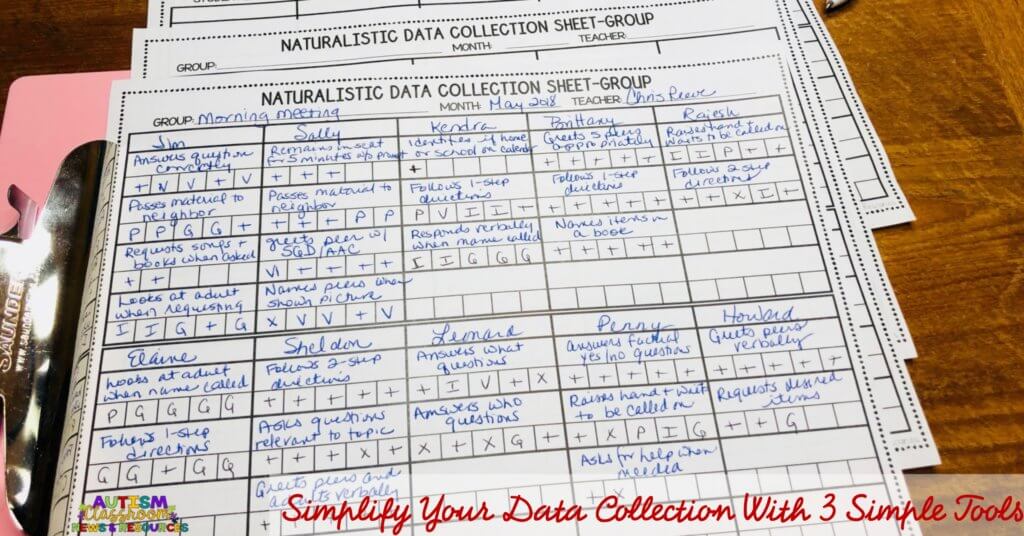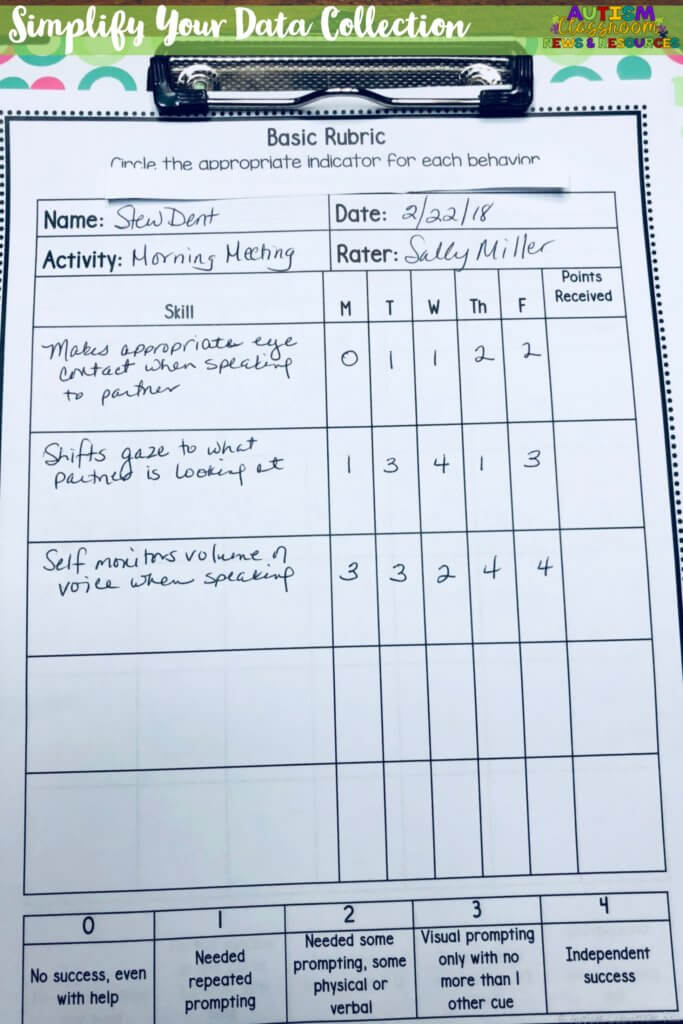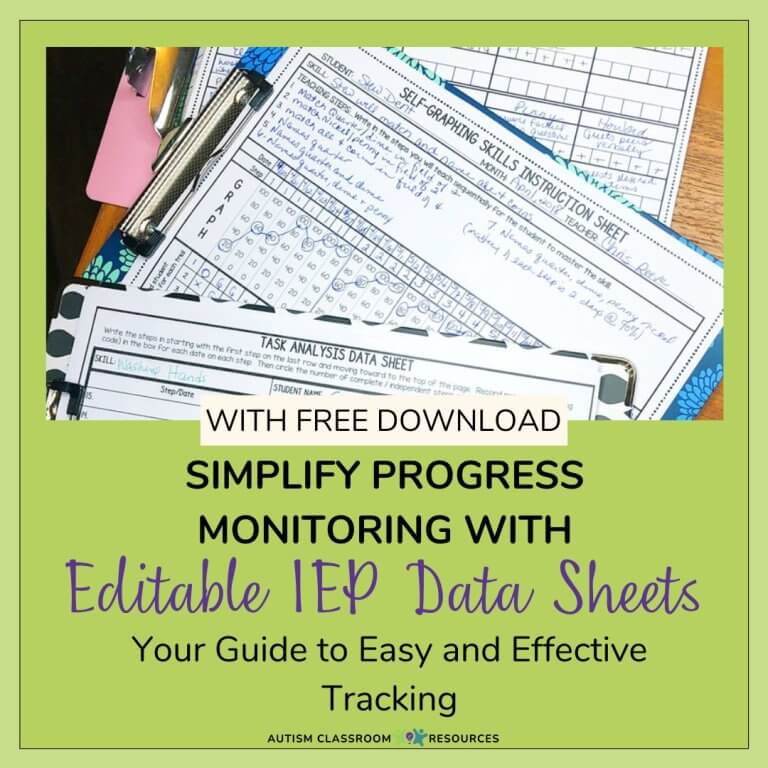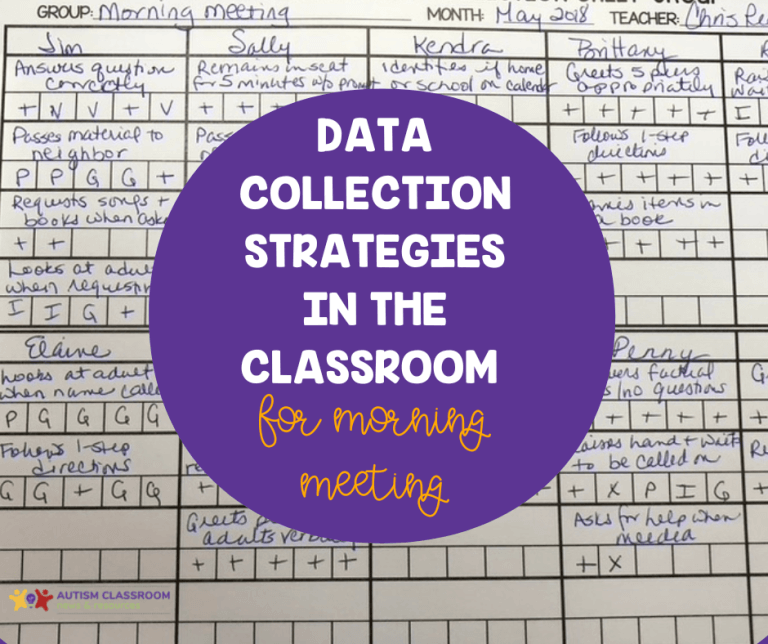Most of us have a love-hate relationship with data and data collection tools. Well, let’s face it…some have a hate-hate relationship. And a few of us have a love-love relationship. But for most teachers, it is one of the most challenging elements of running a classroom. How to take data and balance it with instruction time is a huge issue for us. When you are teaching a group of 6 students, it takes all your energy to keep them engaged….data seems like a nicety at that point. But having the right data collection tools can make the job much easier.
Now I will say this….instruction HAS to come before data collection, unless possibly if you are taking baseline data. Even the best data collection tools won’t help if you don’t have good instruction.
We know that data collected should reflect your instruction as well as the student’s learning. And students aren’t learning if they are wandering away from the table while you are searching for the data sheet. So, instruction has to be the priority. However, you also need data to inform your instruction. You need to know what you should do more of and what isn’t working. Then you need to have data to help you figure out what the problem is. And of course to do that, you need to analyze your data.
![collection of different data sheets on clipboards. [how to simplify your data collection with 3 easy tools]](https://autismclassroomresources.com/wp-content/uploads/2018/04/My-Post-Copy-9.jpg)
[socialpug_tweet tweet=”Forgive my language but, Data on Crap is Crap. You have to prioritize instruction and then data to get meaningful information. #autismclassroom #sped #tamingthedatamonster” display_tweet=”Forgive my language but, Data on Crap is Crap. You have to prioritize instruction and then data to get meaningful information. ” style=”2″]
I created the Mega Pack of Instructional Data Sheets to provide ways to simplify the process of both collecting data and analyzing the data you collect. This set provides easy to use data collection tools so you have what you need at hand. So I thought I would share 3 of those tools that can help you be more efficient and effective with data.
3 Simple Data Collection Tools
#1 – SELF-GRAPHING GOODNESS
So my first data collection tool is one I’ve used for many years – data sheets that graph themselves. Ok, they don’t actually graph themselves, but all you have to do is circle a data point each day. There is no need to transfer the data to another sheet or spreadsheet. You just connect the dots on the same sheet you take the data on, and you can see the progress (or lack of it) immediately.
For those of us who find data collection and student progress reinforcing, it reinforces our instruction for us. Or, if it shows a student isn’t making progress fast enough, we know it sooner rather than later. You don’t want to teach for 9 weeks and then realize that the student isn’t progressing. You want to know that 3 or 4 weeks in so you can make changes as needed.
[socialpug_tweet tweet=”You don’t want to teach for 9 weeks and then realize that the student isn’t progressing. You want to know that 3 or 4 weeks in so you can make changes as needed. #sped #tamingthedatamonster” display_tweet=”You don’t want to teach for 9 weeks and then realize that the student isn’t progressing. You want to know that 3 or 4 weeks in so you can make changes as needed.” style=”2″]
#2 – Work Product as a Data Collection Tool
One of the easiest ways to take data is to keep permanent product that the students complete. For many skills, like writing, looking at their work earlier in the year and comparing them to now is a more complete way to assess progress. It makes progress more tangible than a graph ever can because you can see the outcome.
3 Versions available
However, to take permanent product data accurately, you need to know the conditions under which the product was completed. For instance, did an adult prompt the student all the way through the task? Did a para scribe the answers for a student so the work product is in her handwriting but the student did the work? Did the student have extra time? Or were the instructions modified in some way?
USING WORK SAMPLE LABELS
We need all those answers but it’s hard to remember to write all that down on the paper itself. And keeping it with the paper is most efficient way to organize it. In the Free Resource Library, we have a version of labels to use for recording information about work product. This data collection tool can save you tons of time tracking down information later.
I print them on label paper and then just cut them apart. Then staff completes one for each work product saved. Then just stick them to the back or bottom of the paper itself. It gives staff direction to remember what needs to be recorded and makes sure the information stays with the assignment.
REMINDERS FOR WORK SAMPLES
Just make sure to take data consistently when using work samples. If you try to do it randomly, you may fall into an unconscious pattern of saving products that confirm your expectations (e.g., the best ones when you think the student is making progress). So once a week or every other week, take a sample and then review them every couple weeks to see the progress.
#3 – TRAVEL CARDS as Data Collection Tools
Travel cards are a great way to track both skills and behavior across classrooms. So if you work with students who change classes, travel cards are a great way to get assessments from all those different teachers.
2 Versions and 14 Variations of the Check-off System
You can set travel cards up with social skills you need assessed or even executive functioning skills (e.g., being on time to class) that you need to track. With this set, you can even put the slide on Google Slides and share it with the other teachers. Then they can complete them online as the day goes on. This works well if your student isn’t terribly responsible about bringing his travel card with him.
Bonus
SAMPLE DATA
In addition to the 3 data collection tools above, my Mega Pack of Instructional Data Sheets includes expanded versions of my naturalistic and group data sheets. I’ve written more about taking sample data here (and you can download a free earlier version of the data sheets there as well). The expanded version allows for data to be collected on 10 students for a week (for group) or for 10 activities for 1 student.
RUBRICS
And finally, this set also includes rubric templates you can use to assess social skills and communication skills. And they are useful for assessing writing assignments, presentations and more. In my next post, I will talk about the rubric templates more and how I would use them. It will also include pointers in how to set up the rubrics in the templates. In the meantime, here’s a quick shot of the templates included:
Looking for the data sheets I talk about in this post? They are editable in a PowerPoint format –you can add info, but not change the format of the sheet. Click the pic to check out this editable set in my TpT Store!
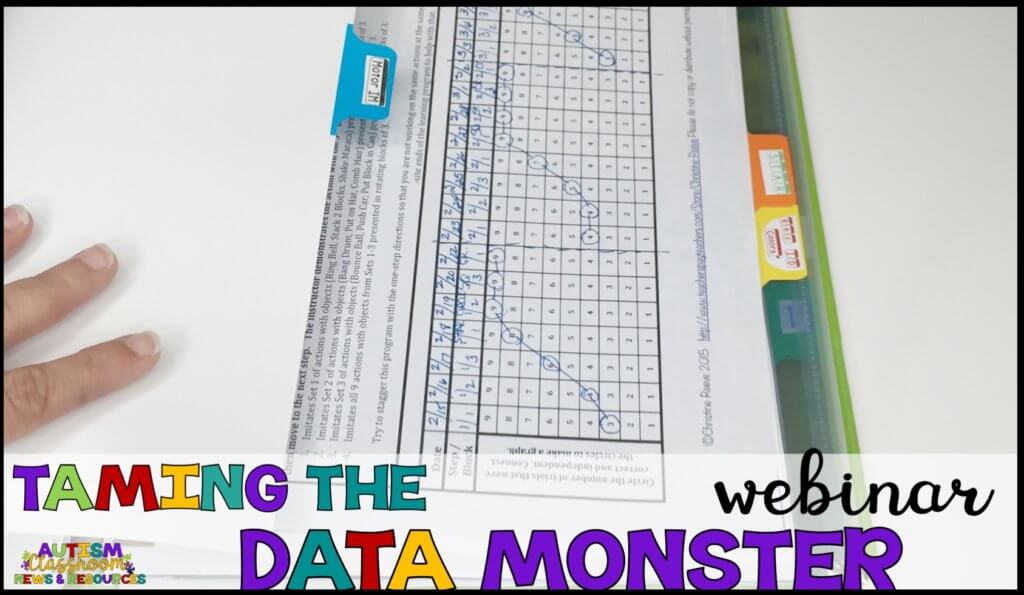
FREE DATA WEBINAR AVAILABLE NOW
Looking for more ideas for data collection? Sign up and watch on demand!





